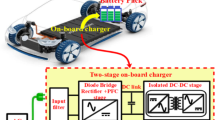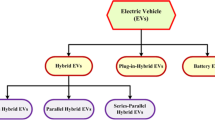Abstract
This paper intends to provide a three-level CUK converter-based on-board electrical vehicle battery charger with improved power quality features. The proposed configuration includes a diode bridge rectifier followed by a DC–DC converter suitable for the universal input voltage variations (85–265 V). It offers reduced voltage stress across the switches, reduced filter size, high efficiency, and improved dynamic response. A feed-forward control scheme is implemented for the proper functioning of the proposed converter under constant current (CC) and constant voltage (CV) modes of operation. In this paper, the mathematical modeling, operational details, and components design of the PFC converter are analyzed in continuous current mode. The simulation study on a 3.2 kW, 400 V proposed converter is carried out with MATLAB Simulink toolbox, and a real-time implementation of the same specifications of the proposed system is developed to verify the simulation study. The steady-state and dynamic behavior of the converter is investigated for power quality features like total harmonics distortion and input power factor with resistive and battery loads. The onboard charger exhibits satisfactory operation in CC and CV modes to a wide range of supply voltage variations.









Similar content being viewed by others
References
Liu R, Dow L, Liu E (2011) A survey of PEV impacts on electric utilities. In: Proceedings of IEEE power and energy society innovative smart grid technologies conference, Anaheim, CA, pp 1–8. https://doi.org/10.1109/ISGT.2011.5759171
Tar B, Fayed A (2016) An overview of the fundamentals of battery chargers. In: Proceedings of IEEE 59th international midwest symposium on circuits and systems (MWSCAS), Abu Dhabi, pp 1–4. https://doi.org/10.1109/MWSCAS.2016.7870048
Solero L (2001) Nonconventional on-board charger for electric vehicle propulsion batteries. IEEE Trans Veh Technol 50(1):144–149. https://doi.org/10.1109/25.917904
Yilmaz M, Krein PT (2013) Review of battery charger topologies, charging power levels, and infrastructure for plug-in electric and hybrid vehicles. IEEE Trans Power Electron 28(5):2151–2169. https://doi.org/10.1109/TPEL.2012.2212917
Shi Y, Tang AK (2017) A single-phase integrated onboard battery charger using propulsion system for plug-in electric vehicles. IEEE Trans Veh Technol 66(12):10899–10910. https://doi.org/10.1109/TVT.2017.2729345
Kim M, Kim BL (2017) An integrated battery charger with high power density and efficiency for electric vehicles. IEEE Trans Power Electron 32(6):4553–4565. https://doi.org/10.1109/TPEL.2016.2604404
Oruganti R, Srinivasan R (1997) Single phase power factor correction: a review. Recent Adv Power Electron Drives 22(6):753–780. https://doi.org/10.1007/BF02745844
Musavi F, Edington M, Eberle W, Dunford WG (2012) Evaluation and efficiency comparison of front end AC–DC plug-in hybrid charger topologies. IEEE Trans Smart Grid 3(1):413–421. https://doi.org/10.1109/ECCE.2011.6063780
Singh B, Singh BN, Chandra A, Al-Haddad K, Pandey A, Kothari DP (2003) A review of single-phase improved power quality AC-DC converters. IEEE Trans Ind Electron 50(5):962–981. https://doi.org/10.1109/TIE.2003.817609
Singh B, Singh S, Chandra A, Al-Haddad K (2011) Comprehensive study of single-phase ac-dc power factor corrected converters with high-frequency isolation. IEEE Trans Ind Inform 7(4):540–556. https://doi.org/10.1109/TII.2011.2166798
International Standard IEC 61000-3-2 (2000) Limits for harmonic current emissions (equipment input current ≤16 A per phase)
Erickson RW, Maksimovic D (2001) Fundamentals of power electronics, 2nd edn. Kluwer, New York
Jovanovic MM, Jang Y (2005) State-of-the-art, single-phase, active power-factor-correction techniques for high-power applications: an overview. IEEE Trans Ind Electron 52(3):701–708. https://doi.org/10.1109/TIE.2005.843964
Wang L, Wu QH, Tang WH, Yu ZY, Ma W (2017) CCM-DCM average current control for both continuous and discontinuous conduction modes boost PFC converters. In: Proceedings of IEEE electrical power and energy conference (EPEC), Saskatoon, SK, pp 1–6. https://doi.org/10.1109/EPEC.2017.8286149
Praneeth AVJS, Williamson SS (2018) A review of front end ac-dc topologies in universal battery charger for electric transportation. In: Proceedings of IEEE transportation electrification conference and expo (ITEC), Long Beach, CA, pp 293–298. https://doi.org/10.1109/ITEC.2018.8450186
Nussbaumer T, Raggl K, Kolar JW (2009) Design guidelines for interleaved single-phase boost PFC circuits. IEEE Trans Ind Electron 56(7):2559–2573. https://doi.org/10.1109/TIE.2009.2020073
Gautam D, Musavi F, Edington M, Eberle W, Dunford WG (2011) An automotive on-board 3.3 kW battery charger for PHEV application. In: Proceedings of IEEE vehicle power and propulsion conference, Chicago, IL, pp 1–6. https://doi.org/10.1109/VPPC.2011.6043192
Praneeth AVJS, Williamson SS (2019) A wide input and output voltage range battery charger using buck-boost power factor correction converter. In: Proceedings of IEEE applied power electronics conference and exposition (APEC), Anaheim, CA, USA, pp 2974–2979. https://doi.org/10.1109/APEC.2019.8721797
Ananthapadmanabha BR, Maurya R, Arya SR (2018) Improved power quality switched inductor Cuk converter for battery charging applications. IEEE Trans Power Electron 33(11):9412–9423. https://doi.org/10.1109/TPEL.2018.2797005
Ruan X, Li B, Chen Q (2002) Three-level converters-a new approach for high voltage and high power DC-to-DC conversion. In: Proceedings of IEEE 33rd annual IEEE power electronics specialists conference (Cat. No. 02CH37289), Cairns, Qld, Australia, pp 663–668. https://doi.org/10.1109/PSEC.2002.1022529
Ruan X, Li B, Chen Q, Tan S, Tse CK (2008) Fundamental considerations of three-level DC–DC converters: topologies, analyses, and control. IEEE Trans Circuits Syst I Regul Pap 55(11):3733–3743. https://doi.org/10.1109/TCSI.2008.927218
Jappe TK, Mussa SA (2009) Discrete-time current control techniques applied in PFC boost converter at instantaneous power interruption. In: Proceedings of Brazilian power electronics conference, pp 1118–1123. https://doi.org/10.1109/COBEP.2009.5347636
Van de Sype DM, De Gusseme K, Van den Bossche AP, Melkebeek JA (2005) Duty-ratio feedforward for digitally controlled boost PFC converters. IEEE Trans Ind Electron 52(1):108–115. https://doi.org/10.1109/TIE.2004.841127
Chen H, Li H, Yang R (2009) Phase feedforward control for single-phase boost-type SMR. IEEE Trans Power Electron 24(5):1428–1432. https://doi.org/10.1109/TPEL.2009.2013953
Author information
Authors and Affiliations
Corresponding author
Additional information
Publisher's Note
Springer Nature remains neutral with regard to jurisdictional claims in published maps and institutional affiliations.
Appendix
Appendix
S. no. | Specific parameters | Values |
|---|---|---|
1 | Single-phase supply voltage | 230 V, 50 Hz |
2 | Input and output inductances (L1, L2) | 5 mH |
3 | Intermediate capacitors (C1, C2) | 10 μF |
4 | Output capacitor (C0) | 3000 μF |
5 | Switching frequency (fs) | 10 kHz |
6 | Load | 400 V/8 A |
7 | Battery nominal voltage | 345 V, 40 AH |
Control parameters: Gains of output PI voltage controller kpv = 0.00005, kiv = 20 for CV mode, gains of the output PI current controller kpi = 0.1, kii = 10 for CC mode and inner PI current controller kp1 = 0.3, ki1 = 7.8 same for both CV and CC mode operation; feed forward gain is kd = 1.8.
Rights and permissions
About this article
Cite this article
Maurya, R., Arya, S.R., Saini, R.K. et al. On-board power quality charger for electric vehicles with minimized switching stresses. Electr Eng 104, 1667–1680 (2022). https://doi.org/10.1007/s00202-021-01407-1
Received:
Accepted:
Published:
Issue Date:
DOI: https://doi.org/10.1007/s00202-021-01407-1




